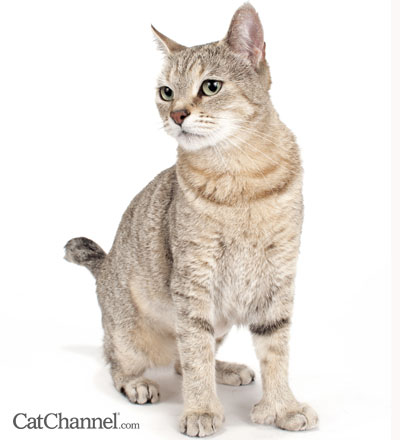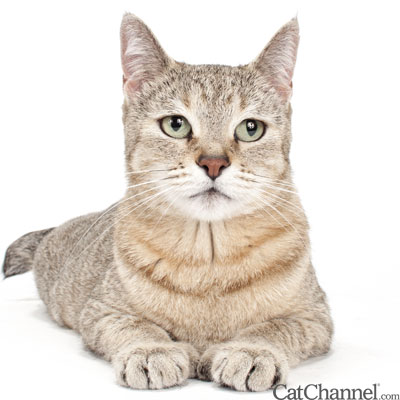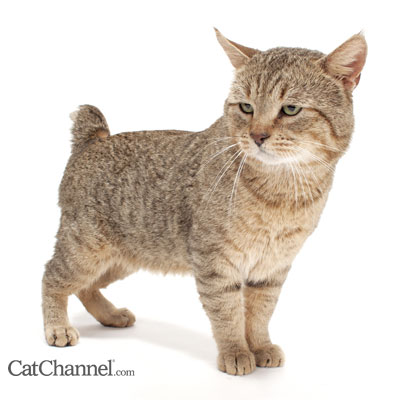Pixiebob CAT PROFILE (on CatChannel.com)
The Pixiebob is a domestic cat visually resembling the
North American Bobcat. Despite its fierce look, the
Pixiebob is noted for its loving, trustworthy and
tractable personality. Heavy brows with bushier hair
above the eyes, lynx tipping on the ears and longer
"mutton chops" on the cheeks
complete the Pixiebob's wild look. The tail can measure
from 1 to 6 inches in length. These cats have
brown tabby markings on a tan or
reddish background and may be polydactyl (having extra
toes).
 |
Pixiebob
Personality and Persistence
By Theresa Meyers
Sharleen Horne searched for the source of the eerie sound. A
baby raccoon apparently had found its way inside, and now
its distressed cry echoed through the house. Horne rounded a
corner and came upon the true source of the noise: her
Pixiebob, Curly. The 4-year-old cat stared at her and then,
with golden eyes half shut, made the noise again.
"I'm always surprised at the sounds they'll make," says
Horne, owner of ExpresivePixie Cattery, in Marysville,
Wash., and breed chairperson for The International Cat
Association. "They don't meow. Instead, they chirp and
chatter; but mimicking a baby raccoon was a new sound even I
hadn't heard."
Pixiebobs or, as some call them, "Pixie-Bobs," constantly
surprise. The breed's wild bobcat looks belie a loving,
playful, devoted nature. The heavy-hooded eyes, spotted coat
and short tail draw attention-people sit up and take notice,
but the incredibly dog-like personality keeps people hooked.
That combination attracted Tonya Butler, owner of
WhistlinPixie Cattery in Phoenix, Ariz., and vice president
of the International Pixiebob Society. "I love the wild
look, but I had to have a breed that would work with my
young children," Butler says. "As far as temperament, with
kids this is the most phenomenal cat for a family."

Legendary Beginnings
The Pixiebob bears a remarkable resemblance to the Pacific
Northwest coastal red bobcat. "At first when these cats came
to me, I didn't believe the stories of matings between wild
bobcats and barn cats," says Carol Ann Brewer, breed founder
and owner of Stone Island cattery in Bellingham, Wash. "When
I had babies, I had to accept it. Their appearance brought
back to me that this was something people had been talking
about for hundreds of years."
In the 1980s, Brewer acquired cats she believed resulted
from unplanned matings of bobcats and barn cats. Because she
had no proof of this, she called them Legend Cats. Two of
them produced a kitten that Brewer named Pixie.
"She had such a wild beauty that I knew I couldn't stand not
having her face around for the rest of my life," Brewer
says. Brewer selected three other Legend Cats from local
sources and set out to create a breed based on Pixie as its
standard. TICA granted the Pixiebob experimental status in
1994. A founding board consisting of Brewer, Bernida Flynn,
Gail Chaney and Pam Richcreek further developed and promoted
the breed, leading to its acceptance into the New Breed and
Color category in 1995 and Championship in May 1998. Because
DNA testing has not revealed any wildcat genetic markers,
TICA classifies the Pixiebob as a domestic cat, not a hybrid
Natural Beauty
Although the Pixiebob's bobcat ancestry remains unproved,
the breed standard explicitly calls for a wild look. This
cat peers at you through hooded, deep-set eyes with bushy
brows. The head has an inverted pear-shape with prominent
whisker pads, a fleshy chin and a broad nose.
Adult males can weigh 12 to 22 pounds, while females weigh 8
to 12 pounds. Their prominent shoulder blades produce a
rolling gait. Deep, powerful flanks, a well-developed chest,
a naturally short tail, a primordial belly pouch and brown
spotted tabby coat with a mousy-gray undercoat all
contribute to their wild appearance. Unlike with any other
breed, the TICA standard allows for polydactyl cats with up
to seven toes per foot.
Like wild bobcats, Pixiebobs can change color with the
seasons. Their coats can vary from warm tones with distinct
markings in the summer to a muted, grayish cast with tipping
that gives the impression of a dusting of snow in the
winter. "I've had people come over in different seasons who
didn't believe it was the same cat," says Gail Chaney, owner
of NativeSon Cattery in Roy, Wash., and a member of the TICA
Pixiebob Breed Committee. While Pixiebobs don't normally
shed much, their winter frost-tipped guard hairs tend to
shed in spring, Horne says.
The breed has long and shorthaired varieties. Shorthairs
have a woolly coat, resilient to the touch and waterproof.
Longhairs have silky coats with a "mutton chop" look on the
cheeks. Both require little, if any, grooming.
Pet-quality kittens might have classic or marble rather than
spotted tabby markings, or their coats may be too dark.
Causes for disqualification in the show ring also include
docked tails, excessively long hair or fine boning,
according to Heather Johnston, owner of Mystic Pixies
Cattery in Orlando, Fla., and secretary of the International
Pixie-Bob Society.
While it has no known health problems, the breed is
extremely sensitive to vaccines, Brewer says. Chaney
recommends feeding meat in addition to commercial food to
provide the nutrition these cats need to grow to their full
size.
Dog in Wildcat's
Clothes
The Pixiebob personality resembles that of a family dog.
Pixiebobs even wag their tails when they play, Johnston
says. They develop strong bonds and may require more time
and attention than the average cat. While open and warm with
their family, they behave cautiously around strangers and
sometimes go into hiding.
Many will play fetch without training, take well to a leash,
love to travel in the car, enjoy playing in water and get
along well with children, Butler says.
With their wild looks and dog-like personalities, Horne says
this cat can convince dog lovers the value of felines. "If
you come up against a person who's had dogs all their life,
this is the cat for them," Horne says. |